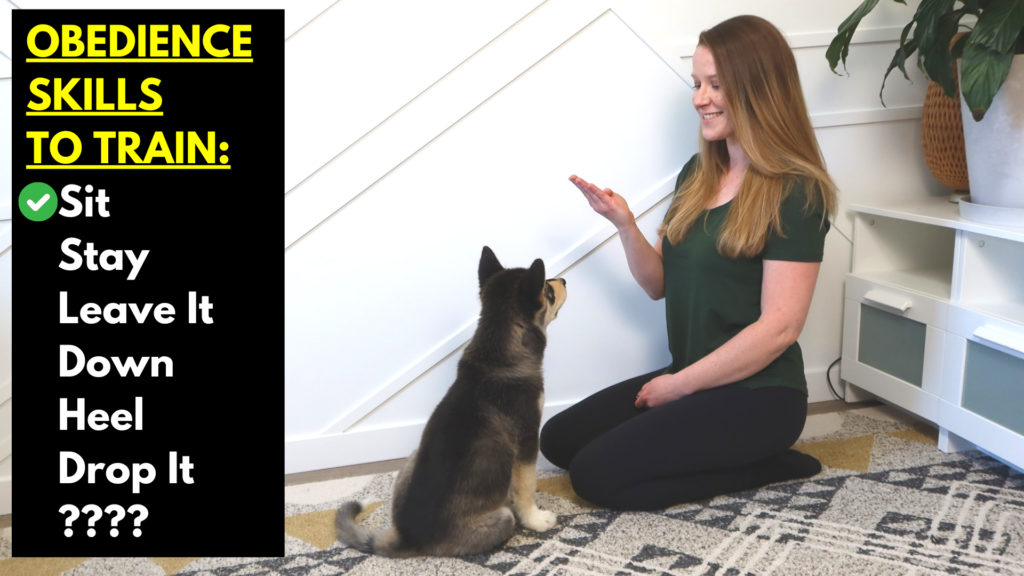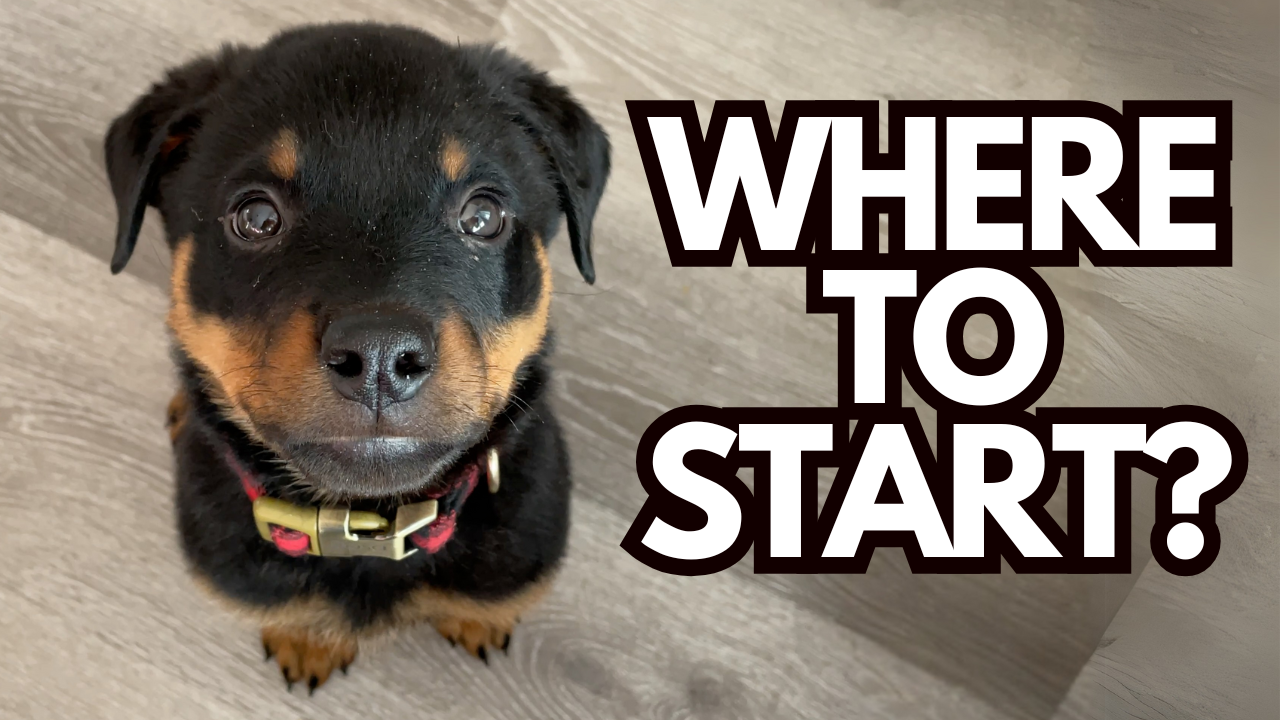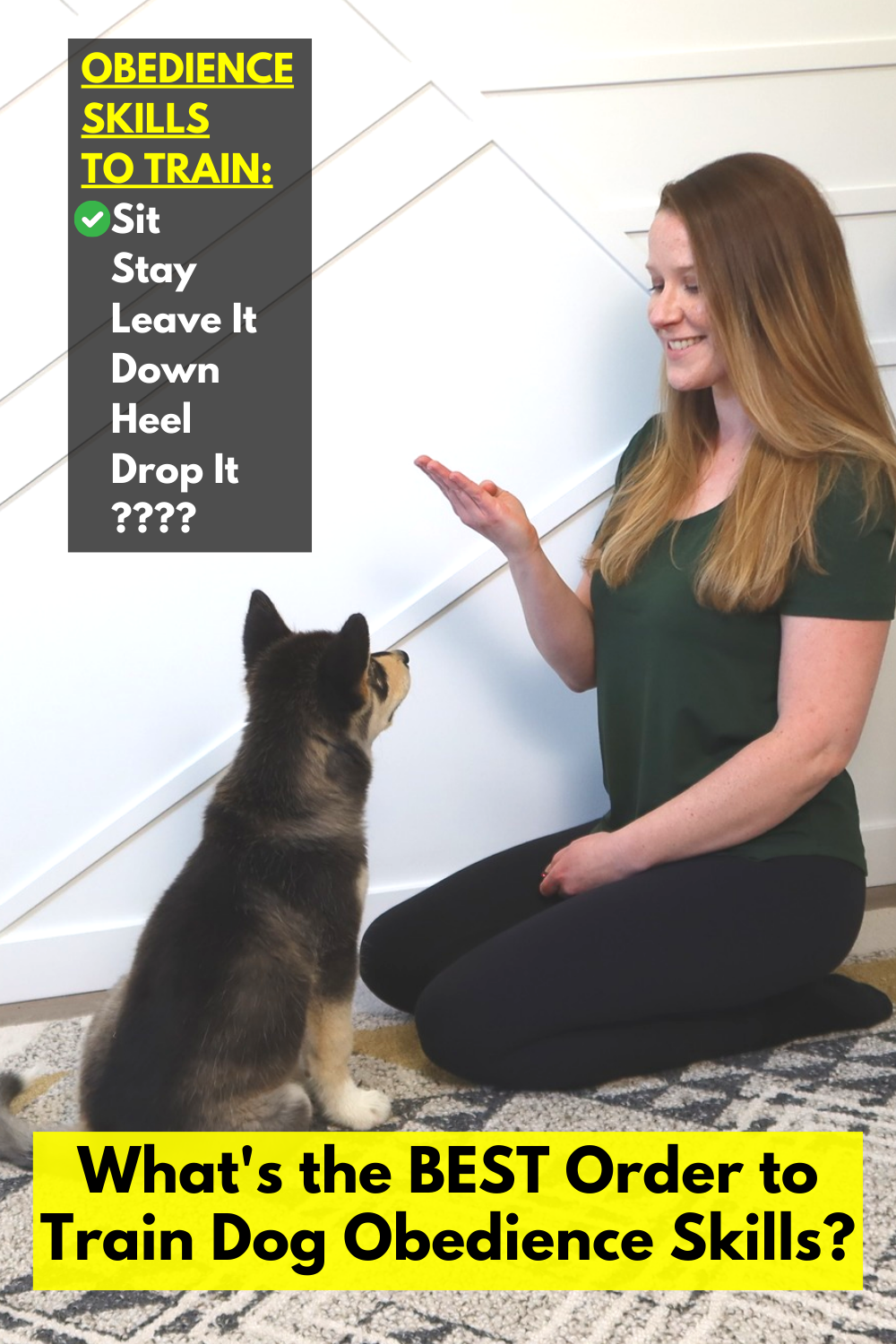I was asked a fantastic question on Youtube:
What’s the BEST order to teach obedience skills to a puppy who’s NEVER been trained before?
I know how overwhelming it can feel when it seems like there’s an endless list of skills that you need to teach your dog.

While I don’t believe there’s a one-size-fits-all “right” order to teach obedience skills, I thought it would be helpful to share the sequence that I typically follow.
Whether I’m working with a young puppy or an older dog, this is the order I typically train obedience cues in. I’ve also linked a step-by-step video tutorial for each skill to help you out further!
Prefer video content? You can watch the Youtube version of this blog post here.
The First Thing I Train EVERY Dog: A Marker Word
A marker word marks the precise moment when your dog has completed a cue correctly (such as sitting when you cue “sit!”) or offered a desirable behaviour that you want them to repeat (such as noticing the mailman, but not barking).
Once a marker word is loaded, it acts as an immediate promise of reward to your dog for that specific action.
This precise timing helps your dog understand exactly what they need to do to earn another reward.
Marker words make training easier, faster, and more effective, which is why I always teach them first.
Learn more about marker words and how to properly load one here: How to Instantly Improve Dog Training Results with a Marker Word
Next, I Train “Sit” and “Down”
I personally think of the cues “sit” and “down” as a bit of a training warm-up.
They’re fun, easy, and quick to teach!
They also introduce lure training, help build a training bond between you and your dog, and are useful prerequisites for other more advanced skills such as “stay”.
I’ll link two step-by-step tutorials that I filmed with my former client Ahsoka:
How to Train Your Puppy to Sit: Step-By-Step Tutorial
Train Your Puppy to Lie Down: Complete Beginner’s Guide
Third, I Train “Leave It!”
“Leave it!” means “Don’t go after that thing you’re interested in”.
It’s a positive interrupter cue.
How to Train Your Dog to LEAVE IT: Complete Beginner’s Guide
Once it’s well trained, I use the “leave it” cue for anything from food I drop while cooking, sidewalk snacks the dog finds on walks (that I’d rather them NOT eat), animals they want to chase, and even as a prerequisite skill to stop counter surfing.
This is a potentially life-saving cue that can stop your dog from eating or chasing dangerous things. I HIGHLY encourage helping your dog master it!
Want to receive more exclusive tips, training insights, and all the latest updates straight to your inbox? Sign up for my FREE newsletter: https://happyhounds.myflodesk.com/newsletter
Fourth, I Train “Drop It”
I’ve noticed that many dog guardians confuse “leave it” and “drop it,” and use them interchangeably, even though they mean completely different actions.
As mentioned, “leave it” means “don’t go after that thing you’re interested in”. It’s preventative and used when your dog doesn’t have the item in their possession yet.
If your dog already has the item in their mouth, then you’d use the cue “drop it” instead. This means “release that item from your mouth!”
How to Train Your Dog to DROP It: Step-by-Step Tutorial
Fifth, I Train “Stay”
“Stay” means “hold that position until I release you”.
Since “leave it” and “drop it” can be so important for the dog’s safety, I always train those skills before working on “stay”.
However, “stay” is still worth teaching!
It can be useful for times such as asking your dog to stay in one place when guests enter the home, when asking your dog to wait for their release cue before exiting a vehicle, for staying in a particular spot during family meals (especially if you have a baby!), or for preventing them from running into dangerous situations.
The 3 D’s of “stay” training are: duration, distance, and distraction. Learn how I train each by watching this:
How to Train Your Dog to Stay: Complete Beginner’s Guide
What About Leash Training??
You might have noticed I haven’t mentioned leash training yet, even though it’s an important obedience skill.
That’s because I view proper leash training a bit differently!
While cues like “sit,” “down,” and “leave it” can be taught in just a few training sessions, leash training is a more complex and longer-term process.
It’s about building good, consistent habits while addressing your dog’s natural instincts to pull, explore, and sniff during walks.
Therefore, right after a marker word is loaded, I encourage starting to work on leash skills for at least 10 minutes per day while also training the other skills on this list.
Want tips and tutorials for leash training?
You can grab my leash training freebie or check out my 6 Weeks to Dream Walks: Step-By-Step Leash Training Program
Happy training!
Disclosure: Happy Hounds uses affiliate links. Purchasing with these links will not cost you any extra, but I get commissions for purchases made through these links. Affiliate links help me to continue to offer free resources & blog posts. I would love if you used them!


+ show Comments
- Hide Comments
add a comment